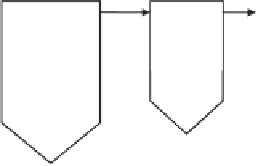Environmental Engineering Reference
In-Depth Information
(A)
Biogas
(B)
Biogas
Gas/solids
separator
Effluent
Effluent
Settling
tank
Liquid
Sludge blanket
Feed
Feed
Solids recirculated
Complete mix reactor with sludge
recirculation
Up-flow anaerobic sludge blanket
Biogas
Biogas
(C)
(D)
Effluent
Effluent
Packed bed
Sludge
granule
Feed
Feed
Up-flow packed bed attached growth
Attached growth anaerobic fluidized
bed
Figure 9.7
Most common anaerobic systems for wastewater treatment.
Attached growth anaerobic fluidized bed reactor
This reactor is a variation of the “upflow attached growth anaerobic expanded-bed reactor,”
which is packed with sand with a diameter between 0.2 to 0.5 mm. The velocity of circulation
(about 2 m/h) is adjusted to allow an expansion of the bed of up to 20 percent. In the attached
growth anaerobic fluidized bed reactor, the speed is increased up to one order of magnitude
(20 m/h) to promote the total bed expansion (Fig. 9.7D) (Tchobanoglous et al., 2004).
Advantages of the fluidized bed reactors are high treatment efficiency, no clogging, small
area requirements, high activity, and good separation of gas from liquid. Disadvantages
include long start-up times, difficulty to control thickness of biolayer, high energy consump-
tion for pumping, and high cost of the equipment (Saravanane and Murthy, 2000).
Posttreatment after anaerobic step
In most cases, anaerobic treatment alone is not enough to achieve a degree of purity that would
allow effluent discharge to surface waters, reuse of the water, or groundwater recharge; there-
fore, it needs an additional polishing step. Water leaving the anaerobic reactor may still con-
tain nutrients (e.g., nitrogen and phosphorus), hydrogen sulfide, odors, suspended solids,
pathogens, color substances, and particulate chemical oxygen demand that need to be reduced
to acceptable levels (Tilche et al., 1996).






























































